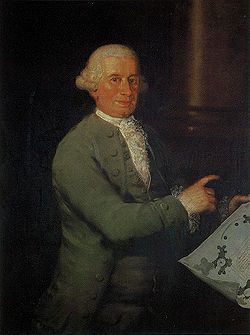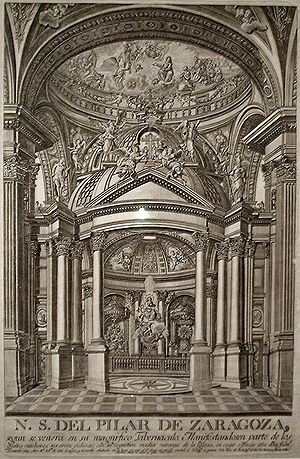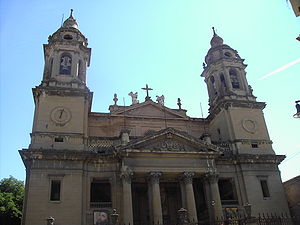
Ventura Rodríguez
Encyclopedia

Ciempozuelos
Ciempozuelos is a town in Spain. It is located in the south of the Community of Madrid. It had a population of 17,769 in 2005 Its origins appear to be Moorish and the name refers to the number of wells that existed in the town. It is clearly not as well-known as its neighbours Chinchón and Aranjuez...
, Rodríguez was the son of a bricklayer
Bricklayer
A bricklayer or mason is a craftsman who lays bricks to construct brickwork. The term also refers to personnel who use blocks to construct blockwork walls and other forms of masonry. In British and Australian English, a bricklayer is colloquially known as a "brickie".The training of a trade in...
. In 1727, he collaborated with his father in the work at the Royal Palace of Aranjuez.
Major works
Ventura's career was remarkably prolific. Between 1749 and 1753, he built the parish church of San Marcos in Madrid. In 1752, he was named the director of architectural studies a the Royal Academy of Fine Arts of San Fernando.
Zaragoza
Zaragoza , also called Saragossa in English, is the capital city of the Zaragoza Province and of the autonomous community of Aragon, Spain...
. Earlier plans by Felipe Busiñac, Felipe Sánchez, and Francisco de Herrera the Younger had not satisfied the demands of the municipality, a convenient distance from the river and proper alignment with the icon and other buildings. In the cathedral of Cuenca
Cuenca, Spain
-History:When the Iberian peninsula was part of the Roman Empire there were several important settlements in the province, such as Segóbriga, Ercávica and Gran Valeria...
, Ventura was asked to construct a Transparente(a glass-roofed altar complex) similar to that made by Narciso Tomé
Narciso Tomé
Narciso Tomé was a Spanish architect and sculptor of the late-Baroque or Rococo period.Born in Toro. With his brother, Diego, he sculpted in 1715, the facade of the University of Valladolid...
in the Cathedral of Toledo
Cathedral of Toledo
The Primate Cathedral of Saint Mary of Toledo is a Roman Catholic cathedral in Toledo, Spain, seat of the Metropolitan Archdiocese of Toledo....
.
Between 1755 and 1767, he decorated the interior of the church of the Royal Monastery of la Encarnación, in Madrid. Then at his peak of influence, the Bourbon
House of Bourbon
The House of Bourbon is a European royal house, a branch of the Capetian dynasty . Bourbon kings first ruled Navarre and France in the 16th century. By the 18th century, members of the Bourbon dynasty also held thrones in Spain, Naples, Sicily, and Parma...
monarchs of Spain, Fernando VI and Carlos III
Charles III of Spain
Charles III was the King of Spain and the Spanish Indies from 1759 to 1788. He was the eldest son of Philip V of Spain and his second wife, the Princess Elisabeth Farnese...
began to favor foreign architects such as the French Jacques Marquet and the Neapolitan Francesco Sabatini
Francesco Sabatini
Francesco Sabatini , also known as Francisco Sabatini, was an Italian architect of the 18th century who worked in Spain.-Biography:Born in Palermo, he studied architecture in Rome...
(nephew of Luigi Vanvitelli
Luigi Vanvitelli
Luigi Vanvitelli was an Italian engineer and architect. The most prominent 18th-century architect of Italy, he practiced a sober classicizing academic Late Baroque style that made an easy transition to Neoclassicism.-Biography:Vanvitelli was born at Naples, the son of a Dutch painter of land and...
).
However, ensconced in 1766 in a role similar to buildings commissioner for the Council of Castille, Ventura played a role in many works. Buildings or remodelings needing official approval came to his purview, and often underwent his scrutiny and change.. He aided in the design of the Convent of the Philippine Augustines of Valladolid
Valladolid
Valladolid is a historic city and municipality in north-central Spain, situated at the confluence of the Pisuerga and Esgueva rivers, and located within three wine-making regions: Ribera del Duero, Rueda and Cigales...
, the college of surgery in Barcelona (1761, home today of the academy of Medicine), the town hall of Haro (1769), and his projects for a new National library and the factory of glass at La Granja.

Arenas de San Pedro
Arenas de San Pedro is a municipality located in the province of Ávila, Castile and León, Spain. According to the 2006 census , the municipality has a population of 6,682 inhabitants. Its seal depicts a large castle located in the town. The seal says "Siempre incendiada", meaning "always on fire"...
(he also built the Royal Chapel for the Convent/Sancturary of San Pedro de Alcántara). He helped remodel the Palacio Municipal de Betanzos
Betanzos
Betanzos is a municipality in Galicia, Spain, in the Province of A Coruña. In Roman times Betanzos was called Carunium or Brigantium. During the Medieval period the settlement was known as Carunio....
.
He was named Maestro Mayor del Ayuntamiento of Madrid
Madrid
Madrid is the capital and largest city of Spain. The population of the city is roughly 3.3 million and the entire population of the Madrid metropolitan area is calculated to be 6.271 million. It is the third largest city in the European Union, after London and Berlin, and its metropolitan...
in 1764. Among other works are portions of the plaza Mayor de Ávila, the Hospital General de Madrid, the facade of the catedral de Toledo, the Sagrario (1761–1764) of the Cathedral of Jaén
Jaén, Spain
Jaén is a city in south-central Spain, the name is derived from the Arabic word Jayyan, . It is the capital of the province of Jaén. It is located in the autonomous community of Andalusia....
, the main retablo for Cathedral of Zamora
Zamora, Spain
Zamora is a city in Castile and León, Spain, the capital of the province of Zamora. It lies on a rocky hill in the northwest, near the frontier with Portugal and crossed by the Duero river, which is some 50 km downstream as it reaches the Portuguese frontier...
(1765–1776), which replaced the one by Joaquín Benito Churriguera (brother of José Benito
José Benito de Churriguera
José Benito de Churriguera was a Spanish architect, sculptor and urbanist of the late-Baroque or Rococo style...
), that had been damaged by the Lisbon earthquake of 1755, the ermita de San Nicasio in Leganés
Leganés
Leganés is a city in central Spain. Part of the greater Madrid conurbation - mainly a satellite-city with a population of 186,066 it is located about 11 km southwest of the city centre....
(1772–1780, the baths at Caldas (1773), the sanatorium at Trillo (1775), the jail at Brihuega
Brihuega
Brihuega is a municipality located in the province of Guadalajara, Spain. According to the 2007 census , the municipality has a population of 2,835 inhabitants....
, and the church at Larravezna. He designed the facade of the cathedral of Pamplona
Pamplona
Pamplona is the historial capital city of Navarre, in Spain, and of the former kingdom of Navarre.The city is famous worldwide for the San Fermín festival, from July 6 to 14, in which the running of the bulls is one of the main attractions...
in Neoclassic style. He created the present church at the Monastery of Santo Domingo de Silos
Monastery of Santo Domingo de Silos
Santo Domingo de Silos Abbey is a Benedictine monastery in the village of Santo Domingo de Silos in the southern part of Burgos Province in northern Spain...
; for this project, he almost destroyed all traces of earlier Romanesque
Romanesque architecture
Romanesque architecture is an architectural style of Medieval Europe characterised by semi-circular arches. There is no consensus for the beginning date of the Romanesque architecture, with proposals ranging from the 6th to the 10th century. It developed in the 12th century into the Gothic style,...
constructions.
He was unable to complete two important commissions, the Puerta de Alcalá
Puerta de Alcalá
The Puerta de Alcalá is a Neo-classical monument in the Plaza de la Independencia in Madrid, Spain. It stands near the city center and several meters away from the main entrance to the Parque del Buen Retiro...
(finished by Sabatini en 1764) or the Basilica of San Francisco el Grande in Madrid (Sabatini again in 1768).

Premonstratensian
The Order of Canons Regular of Prémontré, also known as the Premonstratensians, the Norbertines, or in Britain and Ireland as the White Canons , are a Catholic religious order of canons regular founded at Prémontré near Laon in 1120 by Saint Norbert, who later became Archbishop of Magdeburg...
order, no longer exists. It was torn down by Joseph Bonaparte
Joseph Bonaparte
Joseph-Napoléon Bonaparte was the elder brother of Napoleon Bonaparte, who made him King of Naples and Sicily , and later King of Spain...
, also known as Pepe Plazuelas, who was zealous in opening up plaza spaces in Madrid. The first two architects, Silvestre Pérez and Juan Antonio Cuervo, both disciples of Ventura Rodríguez, refused to carry out the destruction of the church.
He died at Madrid
Madrid
Madrid is the capital and largest city of Spain. The population of the city is roughly 3.3 million and the entire population of the Madrid metropolitan area is calculated to be 6.271 million. It is the third largest city in the European Union, after London and Berlin, and its metropolitan...
.

